Rating:





“12 Angry Men” is not your typical courtroom drama. Skipping all the trial aspects, it shows what happens in the jury room. It is an accurate and realistic lesson from the Constitution that promises to give all defendants a fair and equal trial. That the statement “innocent until proven guilty” is put to the test by 12 men who will debate whether a kid should die for the murder of his father based on the evidence they heard. It is a lesson where “reasonable doubt” will come into play and if a unanimous decision can be reached.
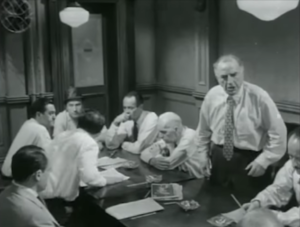
The beauty of “12 Angry Men” comes from the simplistic nature, set-up, and nature of the film. The entire movie takes place in a small, claustrophobic New York City jury room that has no fans, with some of the jurors’ state that it is the hottest day of the year. Only 12 men debate the fate of a young defendant charged with murdering his father.
Where the film excels is the unveiling of information throughout the movie. At the beginning of the film, we pretty much know nothing about the case. All we see is the 12 jurors and the judge. The judge seems to be bored out of his mind. As he gives instructions to the jury, he yawns a lot, and in his mind, you think the case is an open and shut guilty verdict. We don’t see the prosecutor, the defense lawyer, or any of the witnesses. We don’t even know how the defendant pleaded or any of the jurors’ names but their number. What we are left with is that the jury must decide without a reasonable doubt about his guilt. The vote must be unanimous. The last scene before we go to the jury room is the face of a scared 18-year old boy.
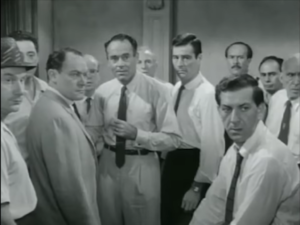
When the jurors make their way into the jury room, we still don’t know anything about the case, but we start to learn about what the jurors are thinking. Many have already made up their minds that the kid is guilty. Some discuss plans they have and ready to get home even before deliberating. Examples of this are: Juror #7 has tickets to the Yankees vs. Indians game while wondering out loud if he will make it or not. Another juror stated that he was so bored through the trial that he almost fell asleep. Juror #12 talked about advertising and made drawings.
When Juror #1 lays down the rules, they decide to do a preliminary vote by a show of hands to see where they stand. After the first vote, 11 of the jurors said they believed he was guilty while Juror #8 believe he is innocent. What is great about this scene is you see the unsureness of individuals and their decisions. Some jurors who chose guilty immediately raised their hands while others were hesitant and going with the group.
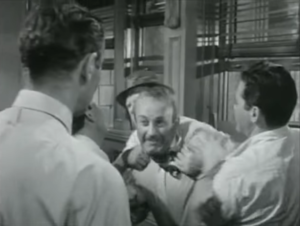
This is where the tension starts amongst the group and the true beauty of the whole film. As each debate and new vote happens, we begin to uncover the personalities, dialogue, beliefs, occupations, prejudices, body language, and thinking of each juror. As you watch, it makes you think about if this really goes on in a jury room. Whether individuals come in with their minds already made up on simple things like race, where a person grew up, lifestyle, and other things to presume whether you’re guilty or not. It shows that no matter what, your life is dependent on 12 people to decide your fate for the rest of your life. That is quite scary for anyone that has been put on trial.

The film shows what happens when people are put in groups to solve a problem. If you ever been to college, you know everything about group projects and whether you hate them or not. As we watch, the jurors are thrust together as each vote is passed, we see significant personalities come out. The alpha dog personalities, brash and hostile personalities, analytical personalities, personalities who can’t make up their mind, and people who just sway from one decision to another. The film does a fantastic job giving you a wide range of people and their thinking.
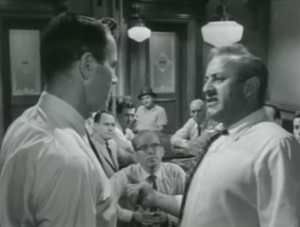
What is great about the story is that it is a short movie (95 minutes long), but it is split up into small sections that flow easily based on the evidence and votes. We see the dynamic of the jury’s mind swing from one end of the spectrum to the other with each new piece of evidence debated. Each piece of evidence is discussed in complete detail that you get a full view of what really happened the night of the crime. The evidence that was presented is a knife and two witness. The first witness was an elderly man who says he heard the murder and saw the defendant fleeing. The second witness was the lady across the street who says she saw the murder happen as the L train was roaring through.
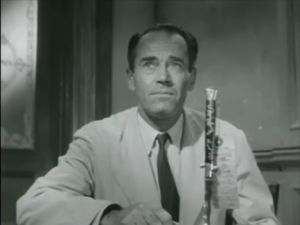
The first thing the story does after the first vote is set the tone on why people chose guilty to convince Fonda to change his vote. Some have the vaguest answers while some say he is a bad kid, people from the slums don’t know anything, or they just want to go home because it seems easy enough. Tempers start to flare when the evidence of the knife comes into the story. Many jurors claim that they never seen a knife like it before. It is something you can’t find anywhere. Fonda, in an illegal way, pulls out the same exact knife and states that two nights earlier, he bought the same knife in a little pawn shop in the same area. With this new information, a new vote is held with another changing their vote.
The movie also presents many scenes that are not only touching but true in today’s world. One of the significant scenes has to do with the race of the individual. We look at the defendant but don’t know what his race or ethnicity is. We have no idea. Some of the jurors make the reference to “these people.” A term that can be used today in any chase. After another vote where the Not Guilty is rising and Guilty is falling, Juror #10 goes on an epic racist rant about, “these people and they don’t know this, and they do this and on and on and on.” As he continues in what he thinks is a memorable way to pull people to his side, one by one, jurors get up and walk to a section of the room by turning their back to him. Even the jurors who think he is guilty cant tolerate his venom or way of thinking until Juror #4 finally says, “Sit down and don’t speak again.” The scene shows that sometimes morality and values have a place when judging someone. It is powerful.
Henry Fonda is sensational in this film. One of his best performances. In the beginning, Fonda plays a man who just simply wants to know the facts even though he heard them in the case. He questions every little thing about the case rather than going with the flow with all the others. You see that his standards and morals are higher than the others because he wants to do the right thing and give the defendant a fair chance. As he makes his case, he tells the other jurors, “We’re talking about somebody’s life here. We can’t decide in five minutes. Supposing we’re wrong?” Throughout the film, Fonda continues to fight for what is right, even when other jurors continue to persuade him otherwise.
“12 Angry Men” is one of the best courtroom drama films of all time that doesn’t happen in the courtroom. It is a film that deals with morality, values, beliefs, personalities, and doing the right thing. It is a film that will question the process of the jury and how they deliberate. It is a film that will entertain you to the fullest while making you wonder if a Not Guilty decision can come.